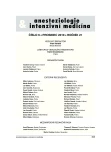Dynamics of the neurofilament pNF-H as a predictor of mortality in children with brain injury
Authors:
Žurek Jiří 1,2; Baštáková Lenka 1; Mihalčin Matúš 1; Forbelská Marie 3; Fedora Michal 1,2
Authors‘ workplace:
Lékařská fakulta, Masarykova univerzita, Brno
1; Klinika dětské anesteziologie a resuscitace, Fakultní nemocnice Brno
2; Ústav matematiky a statistiky, Přírodovědecká fakulta, Masarykova univerzita, Brno
3
Published in:
Anest. intenziv. Med., 21, 2010, č. 6, s. 331-336
Category:
Intensive Care Medicine - Original Paper
Overview
Objective:
The aim of the study was to determine the importance of increased levels of a high-molecular weight form of neuro-filament subunit (pNF-H) in the serum of children with brain injury, as a predictor of mortality.
Design:
Prospective observational study.
Setting:
Department of Anaesthesiology and Intensive Care Medicine, University Hospital. Materials and methods: Total 50 children aged 0–19 years hospitalized between June 2007 and September 2009 with severe brain injury were examined. Serum samples were collected on admission and each following day for the first 6 days of hospitalization. Statistical analysis was performed using Wilcoxon test (p < 0.05). The dynamics of the protein serum levels was determined by ANOVA model and discriminatory values of pNF-H were determined by ROC analysis.
Results:
Eight (8) children died in the observation group. In these patients, compared with the survivors, we observed a significant increase in the serum values in the first 3 days, followed by a stagnation: Day 1: 310 pg/mL vs. 97.7 (p = 0.17); day 2:1307 pg/mL vs. 153 (p = 0.004); day 3: 2640 pg/mL vs. 227 (p = 0.006); day 4: 2100 pg/mL vs. 199 (p = 0.001); day 5: 847 pg/mL vs. 467 (p = 0.03); day 6: 1762 pg/mL vs. 573 (p= 0.03). The results of ROC analysis suggest that the levels of pNF-H measured from the second to the sixth day of hospitalization are a suitable predictor of mortality.
Conclusion:
A significant relation of elevated serum levels of pNF-H and mortality was found in patients after cranio-cerebral injury.
Key words:
head injury – neurofilament – biomarker – dynamics – children
Sources
1. Brichtová, E. Kraniocerebrální poranění v dětském věku. 1. vyd. Praha: Triton, 2008. P. 140 s. ISBN 978-80-7387-087-4.
2. Ingebrigtsen, T., Romner, B. Biochemical Serum Markers of TBI. The Journal of Trauma Injury. Infection and Crit. Care, 2002, 52, p. 798–808.
3. Anderson, K., Scheff, S., Miller, K., Roberts, K., Gilmer, L., Yang, C., Shaw, G. The Phosphorylated Axonal Form of the Neurofilament Subunit NF-H (pNF-H) as a Blood Biomarker of Traumatic Brain Injury. Journal of Neurotrauma, 2008, 25, 9, p. 1079–1085.
4. Hirokawa, N., Glicksman, M. A., Willard, M. B. Organization of mammalian neurofilament polypeptides within the neuronal cytoskeleton. J. Cell Biol., 1984, 98, p. 1523–1536.
5. Lee, M. K., Cleveland, D. W. Neurofilament subunit NF-H modulates axonal diameter by selectively slowing neurofilament transport. Curr. Opin. Cell Biol., 1994, 6, p. 34–40.
6. Strong, M. J., Strong, W. L., Jaffe, H., Traggert, B., Sopper, M. M., Pant, H. C. Phosphorylation state of the native high-molecular-weight neurofilament subunit protein from cervical spinal cord in sporadic myotrophic lateral sclerosis. J. Neurochem., 2001, 76, p. 1315–1325.
7. Teasdale, G., Jennett, B. Assessment of coma and impaired consciousness. A practical scale. Lancet, 1974, 2, p. 81–84.
8. Tepas, J. et al. The Pediatric Trauma Score as a predictor of injury severity in the injured child. J. Pediat. Surg., 1987, 22, p. 14–18.
9. Casmiro, M., Maitan, S., De Pasquale, F., Cova, V., Scarpa, E., Vignatelli, L. Cerebrospinal fluid and serum neuron-specific enolase concentrations in a normal population. Eur. J. Neurol., 2005, 12, 5, p. 369–374.
10. Pineda, J. A., Wang, K. K., Hayes, R. L. Biomarkers of proteolytic damage following traumatic brain injury. Brain Pathol., 2004, 14, p. 202–209.
11. Haqqani, A. S., Hutchison, J. S., Ward, R., Stanimirovic, D. B. Biomarkers and diagnosis; protein biomarkers in serum of pediatric patients with severe traumatic brain injury identified by ICAT-LC-MS/MS. J. Neurotrauma, 2007, 1, p. 54–74.
12. Lewis, S. B., Wolper, R. A., Miralia, L., Yang, C., Shaw, G. Detection of phosphorylated NF-H in the cerebrospinal fluid and blood of aneurysmal subarachnoid hemorrhage patients. J. Cereb. Blood Flow Metab., 2008, 28, p. 1261–1271.
13. Shaw, G., Yang, C., Ellis, R. et al. Hyperphosphorylated neurofilament NF-H is a serum biomarker of axonal injury. Biochem. Biophys. Res. Commun., 2005, 336, p. 1268–1277.
14. Lo, T. Y., Jones, P. A., Minns, R. A. Pediatric brain trauma outcome prediction using paired serum levels of inflammatory mediators and brain specific proteins. J. Neurotrauma, 2009, 26, 9, p. 1479–1487.
15. Buki et al. All roads lead to disconnection? – Traumatic axonal injury revisited. Acta Neurochirurgica, 2006, 148, p. 181–194.
16. Xue, Y. L., Dong, F. F. Diffuse axonal injury: Novel insights into detection and treatment. J. Clin. Neurosci., 2009, 16, 5, p. 614–619.
17. Meythaler, J. M. et al. Amantadine to improve neurorecovery in traumatic brain injury-associated diffuse axonal injury: a pilot double-blind randomized trial. J. Head Trauma Rehabil., 2002, 17, 4, p. 300–313.
Labels
Anaesthesiology, Resuscitation and Inten Intensive Care MedicineArticle was published in
Anaesthesiology and Intensive Care Medicine

2010 Issue 6
Most read in this issue
- Septic shock in fatal pneumonia caused by Staphylococcus aureus: The significance of producing Pantone-Valentine leukocidine – case report
- Thrombocytes in sepsis
- Comparison of patient satisfaction after general and regional anaesthesia in total hip and knee replacement surgery
- High frequency jet ventilation applied via a catheter for Fantoni’s tracheostomy
